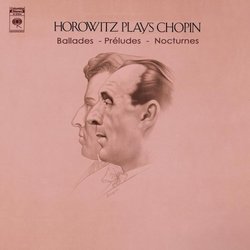| All Artists: Frederic Chopin, Vladimir Horowitz Title: Horowitz Plays Chopin: Ballades, Préludes, Nocturnes Members Wishing: 1 Total Copies: 0 Label: Sony Release Date: 9/30/2003 Album Type: Limited Edition Genre: Classical Styles: Chamber Music, Forms & Genres, Ballads, Historical Periods, Classical (c.1770-1830), Modern, 20th, & 21st Century Number of Discs: 1 SwapaCD Credits: 1 UPC: 827969042823 |
Search - Frederic Chopin, Vladimir Horowitz :: Horowitz Plays Chopin: Ballades, Préludes, Nocturnes
 | Frederic Chopin, Vladimir Horowitz Horowitz Plays Chopin: Ballades, Préludes, Nocturnes Genre: Classical
|
Larger Image |
CD Details |
CD ReviewsHorowitz's Captivating Chopin Hank Drake | Cleveland, OH United States | 04/10/2007 (5 out of 5 stars) "Vladimir Horowitz (who had a Polish grandmother and was fond of pointing out that he was "half as much a Pole as Chopin"), recorded more of Chopin's music than that of any other composer.
Horowitz made four (approved) recordings of the Chopin's Ballade in G-Minor. Truth be told, he was never entirely successful in the work, finding difficulty in balancing the episodic and structural elements. The versions here, from the 1965 return concert and 1968 television recital, are the most successful technically and musically. Chopin described his Opus 16 Preludes as mirroring his life, with no beginning and a sad ending. Horowitz seldom programmed the Preludes in concert and recorded only the two included here: the B Minor and the D-flat Major. They are straightforward and non-virtuosic. Horowitz was fanatically passionate about Ignaz Friedman's performances of the Nocturnes, but recorded surprisingly few himself. The Nocturne in F-Minor, from the 1968 TV recital, is too large dynamically, overly focused on detail at the expense of the whole, and the piece emerges as a collection of details. The two Nocturnes from 1989 are another story indeed. There is a rare sense of repose, at times an almost deathly calm, about these performances. There is also Horowitz's rare ability to weight the various elements of melody, harmony, and accompaniment, down to the smallest micron. Horowitz' floating of the top, middle, and lower lines, interweaving them effortlessly, is in many ways more stunning than any kind of thundering virtuosity. It was not uncommon for Horowitz to bring to light a rarely played work by a well known composer, which was the case with Chopin's Introduction & Rondo in E-flat. This early composition (probably written for Chopin's most advanced pupils) abounds with glittery passagework and technical configurations similar to his Concertos (which Horowitz never recorded). Under Horowitz's hands, the work exceeds the boundaries of mere salon piece and emerges as a virtuoso tour de force. " |

 Track Listings (16) - Disc #1
Track Listings (16) - Disc #1